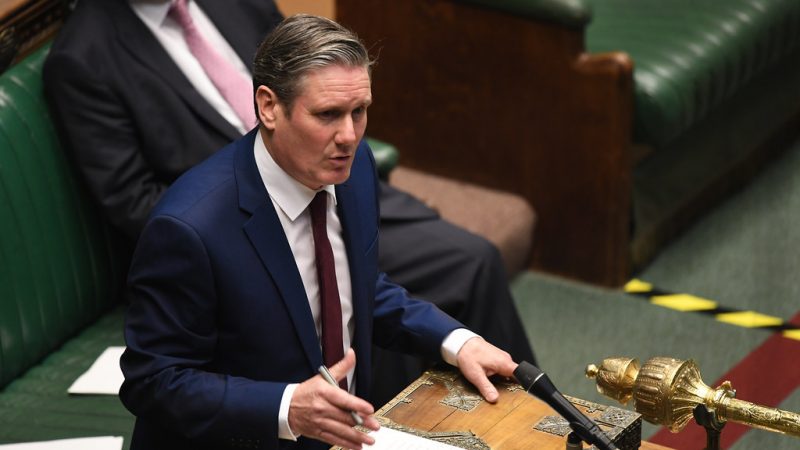Labour and Starmer should look to Harold Wilson’s election victory in 1964 for answers.

Samuel McIlhagga is a freelance journalist.
Whether the comparisons are warranted or not, many politicians have been juxtaposed to their historical and ideological forebears.
At a glance, Boris Johnson is compared to Churchill, Joe Biden to both FDR and Jimmy Carter, Emmanuel Macron to Charles de Gaulle, Donald Trump to Ronald Regan and Andrew Jackson.
This is the work of politicians’ vanity, newspaper columnists needing an entertaining topic and government PR teams keen to historically ground policy offerings in the public consciousness.
Indeed, both media pundits and Labour Party insiders have decided that Keir Starmer’s leadership might be analogous to that of Clement Attlee. Attlee unexpectedly won a landslide for the party in 1945 by offering massive investment, nationalisation and welfare spending after the war.
In some ways, the comparison is apt: both Starmer and Attlee have struggled to criticise a Tory government during a national crisis, both leaders are legally trained technocrats who find themselves facing off against public school former journalists (Churchill was a war correspondent) and the Labour Party now has the opportunity to construct a society after the pandemic that serves key workers just as Attlee promised to “win the peace” for the soldiers, nurses and air-raid wardens of WWII.
1945 comparison has pitfalls
However, the 1945 comparison falls down when looked at more closely. Firstly, the end of the pandemic will probably come well before Johnson calls an election: leaving the Conservative Party plenty of time to benefit from a return to normality.
Secondly, the next general election will come in 2024, after 14 years of Conservative rule, while the 1945 election bookended 10 years of National Government shared between the Tories and Labour.
Thirdly, Attlee and Starmer do not share the same kind of meritocratic background. The current Labour leader is a contemporary product of provincial grammar schools and universities, Attlee a patrician socialist of the Fabian mould.
Instead, Labour and Starmer should look to Harold Wilson’s election victory in 1964 as a more concrete comparison from which to draw lessons. For instance, the United Kingdom of 1964 has a lot more in common with 2021 than 1945 and Starmer is closer to Wilson than Attlee. Both face enduring questions, that have not gone away, over Northern Ireland, Europe, technological automation, and Britain’s place in the world.
An era of great change
They are also both in charge of the Labour Party during an era of great cultural change.
For instance, social and demographic shifts had produced a younger generation radically out of step with their grandparents and parents. The boomers of 1964 broke the social and cultural consensus with the sexual revolution, free love, individualism, divorce, anti-nuclear and anti-censorship activism in much the same way that millennials have with movements such as MeToo, BLM, Extinction Rebellion, intersectionality, and new codes of speech that have sought to rectify the excesses of the former generation.
Starmer is having to negotiate this shifting ground just as Wilson had to over the Vietnam War and the so-called ‘permissive society.’
1964 also saw a larger proportion of the population go on to higher education after the Robbins Report of 1963 and the growth of the plateglass universities from 1961. Labour benefitted from this larger graduate population in 1964 just as it has from the student boom under Tony Blair since the 1990s. By comparison, in 1950, only 3.4% of the population were graduates after 5 years of Labour government.
Labour’s 1964 manifesto bares contemporary resonance
Many of the UK’s economic problems outlined in Labour’s 1964 manifesto also seem shockingly current.
There is an abiding concern, in the manifesto, over house and rent prices that have: “pushed housing and flats beyond the reach of many ordinary families and have condemned yet another generation to squalid and over-crowded housing.”
Labour managed to get young families and people onside by fighting infamous slum landlords like Peter Rachman. The current spike in house prices and rents compared to wage rises and the Conservative Party’s cosy relationship with luxury developers has created an opportunity for the Labour Party to repeat the efforts of Wilson by building over 400,000 homes a year in both the public and private sector.
Succession of Old Etonians
The thirteen years of Conservative rule before the 1964 election victory also echo the current twelve years of Conservative administration. Both have seen a succession of Old Etonians filter through the leadership while bungling foreign policy (the Suez Crisis and the Libyan intervention) and failing to keep scandals under wraps (the Profumo affair and the Greensill/Downing Street Flat fiasco).
In 1945, Attlee faced an electorate that was socially conservative and employed predominantly in manual labour, the British Empire was still intact and the union stable. Questions on Europe, identity and automation had not yet become dominant issues.
Wilson, and now Starmer, wanted and want to govern a country that is far more complex, divided and fragile. Starmer needs to look to Wilson, not Attlee, for answers.
To reach hundreds of thousands of new readers we need to grow our donor base substantially.
That's why in 2024, we are seeking to generate 150 additional regular donors to support Left Foot Forward's work.
We still need another 117 people to donate to hit the target. You can help. Donate today.



